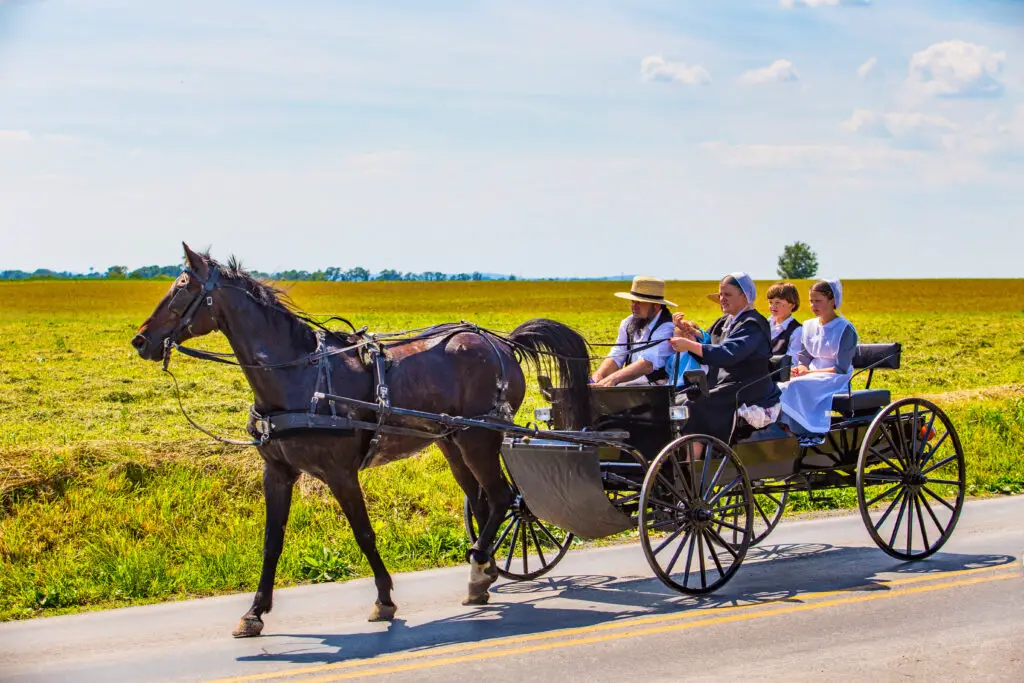1. Driving Cars

Mennonites often drive cars just like anyone else, though they may prefer simple models without flashy features. You might see a Mennonite family in a modest sedan or a minivan, heading to work or running errands. The Amish, however, strictly stick to horse-drawn buggies, believing that cars promote too much independence and separation from their communities. For them, avoiding automobiles is a way to remain humble and stay connected to their traditions says Discover Lancaster.
Since Mennonites drive, they can travel greater distances for work, shopping, or visiting family members in other areas. This freedom allows them to take jobs outside their immediate communities, while Amish people often work within walking or buggy distance. The ability to drive also means Mennonites can interact more easily with the outside world. Meanwhile, the Amish rely on non-Amish drivers, known as “English,” when longer trips are unavoidable.
2. Using Electricity in Their Homes

Most Mennonites have no issue with flipping on a light switch, charging their phone, or watching TV in the evening. Their homes are typically wired with electricity, allowing them to use modern appliances like refrigerators, washing machines, and even air conditioning. The Amish, on the other hand, avoid being connected to the electrical grid, believing it introduces worldly temptations. Instead, they use alternative methods, such as gas lamps for lighting and iceboxes for refrigeration shares Reddit.
This difference means Mennonites can enjoy the conveniences of modern living without restriction. They can use the internet, listen to music on the radio, or even work in tech-related jobs. The Amish, however, find ways to adapt without electricity, using generators or battery-powered tools in certain cases. Their goal is to remain separate from modern influences, which electricity represents to them adds Freedom for All Americans.
3. Wearing Modern Clothing

Mennonites often dress in plain yet modern clothing, blending in with the general public while maintaining modesty. Women may wear simple dresses, skirts, or even jeans, while men typically wear button-down shirts and slacks. The Amish, however, wear strictly traditional attire that has remained unchanged for centuries. Women wear long, solid-colored dresses with aprons and bonnets, while men wear suspenders, broad-brimmed hats, and beards without mustaches shares Quora.
For Mennonites, clothing is a personal choice guided by faith but not necessarily dictated by strict rules. Many dress conservatively but still shop at regular stores, choosing practical and modest outfits. The Amish, however, believe that dressing uniformly reinforces their sense of community and separation from the modern world. Their clothing choices are a visible symbol of their commitment to their faith and way of life.
4. Attending Higher Education

Mennonites often encourage their children to pursue higher education, attending colleges and universities if they choose. Many Mennonites become teachers, nurses, or even work in business and technology fields. The Amish, in contrast, generally end formal education after eighth grade, believing that further schooling introduces unnecessary worldly influences. Instead, they focus on practical skills, such as farming, carpentry, or homemaking, which are essential for maintaining their way of life.
Since Mennonites value education, many integrate into modern society while still holding onto their religious beliefs. They may attend religious-affiliated colleges or secular universities, often excelling in various professional careers. The Amish see this level of education as a distraction from their faith and simple lifestyle. To them, maintaining their traditions is more important than academic achievements.
5. Using the Internet and Social Media

Mennonites generally have access to the internet and often use it for work, education, or staying in touch with family. Many have social media accounts, operate websites for their businesses, or even engage in online communities. The Amish, however, strictly avoid the internet, believing it brings too many outside influences into their lives. They see it as a gateway to worldly temptations that could weaken their faith and values.
Because Mennonites embrace technology, they can easily stay informed and connected with the broader world. They use smartphones, email, and even Zoom for work or religious meetings. The Amish, in contrast, maintain their traditional communication methods, relying on in-person visits, letters, or community bulletin boards. Their focus is on keeping their way of life as undisturbed by modern trends as possible.
6. Watching Television and Movies

Mennonites, particularly the more modern groups, have no issue watching television or movies for entertainment or education. Many enjoy family-friendly programming, documentaries, or even streaming services. The Amish, however, completely reject TV and movies, believing they expose their communities to harmful outside influences. They view these forms of entertainment as distractions that promote vanity, violence, or unwholesome behavior.
Because Mennonites allow TV, they can engage with pop culture, stay informed about world events, and enjoy entertainment like anyone else. Some may limit their viewing based on personal beliefs, but they do not have strict bans. The Amish, on the other hand, avoid visual media entirely, preferring books, storytelling, and community activities for leisure. Their goal is to maintain a life centered on faith and simplicity rather than outside entertainment.
7. Listening to Music with Instruments

Mennonites enjoy music and often play instruments, whether in church, at home, or for fun. Some Mennonite churches incorporate hymns with piano or guitar accompaniment, while others even embrace contemporary Christian music. The Amish, however, only sing a cappella hymns, avoiding musical instruments entirely. They believe that instruments encourage self-expression and individualism, which could lead to pride and disrupt community unity.
This difference means Mennonites can experience a wide variety of musical styles and even perform in bands or choirs. Amish communities, however, preserve their centuries-old tradition of slow, unaccompanied singing. For them, music is strictly a spiritual practice, not a form of entertainment. Their approach keeps their worship solemn and focused solely on faith rather than personal enjoyment.
8. Playing Organized Sports

Many Mennonites enjoy playing sports, whether casually or as part of a team. Some participate in school or community leagues, playing soccer, basketball, or baseball. The Amish, however, discourage competitive sports, believing they promote rivalry, pride, and unnecessary physical aggression. While Amish children may play informal games like tag or softball, organized competition is avoided.
Mennonites see sports as a healthy way to stay active and socialize. Some even participate in marathons or join local gym memberships. The Amish, in contrast, focus on physical labor as their primary source of exercise. Their simple lifestyle does not encourage activities that create a strong sense of competition or individual achievement.
9. Voting in Elections

Many Mennonites believe in civic engagement and vote in elections, seeing it as a responsibility to contribute to society. Some even run for public office or participate in activism for social justice causes. The Amish, on the other hand, rarely vote, preferring to remain separate from government affairs. They believe that politics is too worldly and that God, not man, ultimately governs all things.
Mennonites, by voting, feel they can influence laws and policies that align with their values. They may advocate for peace, environmental care, or religious freedom. The Amish, however, see government involvement as unnecessary for their way of life. They prefer to focus on their own self-sustaining communities rather than engaging with political systems.
10. Owning and Operating Businesses with Advertisements

Mennonites frequently run businesses and advertise them through signs, websites, and social media. They own shops, restaurants, and even large corporations, fully embracing modern commerce. The Amish also run businesses but avoid advertising, believing it promotes pride and self-importance. They rely on word of mouth and community connections instead of marketing strategies.
Because Mennonites use advertising, they can reach broader customer bases and expand their businesses. This allows them to thrive in modern economies while maintaining their faith. The Amish prefer a more discreet approach, selling handmade goods or produce without drawing too much attention. Their goal is to keep their businesses as humble as their way of life.
11. Using Modern Medicine

Mennonites generally seek modern medical care when needed, visiting doctors, hospitals, and even using prescription medications. They trust in science and healthcare advancements while still believing that faith plays a role in healing. The Amish, on the other hand, are often hesitant to rely on modern medicine, preferring natural remedies and home treatments first. While they will seek medical help in emergencies, many avoid preventive care or treatments seen as too invasive.
Mennonites typically have health insurance and follow standard medical practices like vaccinations and routine checkups. They see medical care as a practical necessity rather than a spiritual dilemma. The Amish, however, often rely on community aid to cover medical expenses, sometimes traveling long distances to visit doctors who respect their beliefs. Their focus is on maintaining a lifestyle that minimizes dependence on outside systems, including healthcare.
12. Living in Individual Homes Instead of Communal Settlements

Mennonites live in regular neighborhoods or rural areas, much like anyone else, with individual homes for each family. They integrate into society while maintaining close ties to their religious community. The Amish, in contrast, live in tight-knit settlements where homes, farms, and businesses are all within close proximity. Their communities are designed to be self-sufficient, ensuring that members rely on each other rather than outsiders.
Because Mennonites live independently, they have more freedom in choosing where to settle, work, and raise their families. Some move to cities or suburbs, while others prefer rural living. The Amish, however, maintain a communal structure that reinforces their traditions and values. Their goal is to create an environment where modern influences are kept at bay, allowing their faith and customs to remain unchanged.
